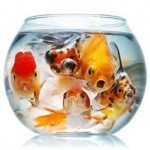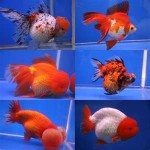Now to learn about the most important things you need to know about raising healthy goldfish in both ponds and tanks, good water quality. Just because the water is clear it doesn’t mean it’s perfect for the fish. Many factors determine whether the water is suitable for a healthy living environment for goldfish.
Regularly testing the water quality is essential and a routine maintenance schedule should be established. It’s best to perform these weekly checks when changing out the water.
If you have a goldfish that is showing signs of distress now, check out the article on this link to treat the aquarium water problem.
1. Check for high levels of ammonia, nitrites, and nitrates
Especially in a new tank or pond, ammonia, nitrite, and nitrate levels can be elevated, providing a very toxic environment for goldfish. The level of ammonia increases over time from goldfish feces and decaying plants. When bacteria feed on ammonia, nitrite is formed. Nitrite eventually turns into nitrate.
Both ammonia and nitrite are extremely dangerous for goldfish.
Although nitrates are not as toxic, they’re still unhealthy for the fish. Over the first few weeks of using a new tank or pond, make sure chemicals are used to neutralize the water and remove the ammonia, nitrites, and nitrates.
The key to healthy water in a fish tank or pond lies in how often the water is changed out. If attention is paid and a routine is established, chances are good the water quality will stay at a healthy level. Healthy goldfish are found in regularly maintained tanks and ponds.
When water quality is not regularly monitored in a tank or pond, bacteria invades, affecting every living thing in the ecosystem rather than just the goldfish.
There are good and bad bacteria that live in fish tanks and ponds. Good bacteria make up the biological filter and break down ammonia and nitrites so they can be removed from the water.
Bad bacteria also exists in the tank or pond, but most of the time, doesn’t affect the goldfish until they are sick or weakened. With weaker immune systems, the goldfish are not able to fight the bad bacteria, which in turn makes the fish even sicker.
Care needs to be taken when introducing new goldfish, plants, or water to the environment. New additions can carry outside bacteria into the already established tank or pond.
Fish Tank Filter System
High bacteria levels in the goldfish’s environment will eventually result in skin infections, fin or mouth rot, or ultimately, death.
To stop this from happening, it’s important to keep the water clean. An effective filter system will also help clean the water, providing goldfish with a healthier place to live.
The filter can also act as an aeration agent, helping to keep the oxygen levels in the water healthy for goldfish. It’s very important to keep the water moving to stop it from going stale.
To make sure goldfish live long, healthy lives, it’s critical to provide them with quality water to live in that is free of all the toxins that will shorten their lives. When healthy, goldfish can be one of the prettiest, graceful creatures to watch and bring people much joy and tranquility.
2. Check the pH levels
Acidity and alkalinity of the water is measured using pH levels. The water’s pH level can be tested using commercial strips that, when exposed to the water being tested, turns a certain color. The color of the paper is compared on a scale running from 0 (most acidic) to 14 (most alkaline) with 7 being the neutral mark.
Ideally, goldfish are happiest living in water between 6 and 8. If they have to, they can live in water that is slightly alkaline.
Goldfish that live in highly acidic tanks or ponds can end up with excess slime on them, anorexic tendencies, and blood streaking in the fins. Water that is too alkaline can cause goldfish to gasp at the water’s surface and produce excess slime on their scales.
3. Check the hardness of the water
There are 2 different ways to check for the hardness of water. One way is to measure the general or total hardness, expressed in dH, GH, or dGH. Ideally, goldfish live in water between 4 dH and 20 dH. Carbonate harness is another way to measure the water, expressed in mg/L.
In an ideal tank, the water should be between 70 mg/L and 400 mg/L. These tests are readily available.
4. Check the chlorine levels
High levels of chlorine are not good for goldfish. Chemical treatments can be applied to the tanks and ponds to remove chlorine from the water.
5. For ponds, check the algae levels
Although some algae is healthy for fish to live with, a large amount isn’t.
Algae is formed when there’s an immense amount of sunlight coming into the pond. In addition, algae feeds on ammonia and nitrites. The more ammonia and nitrites there are in the water then the greater the level of algae.
If the over-abundance of algae isn’t dealt with effectively, the goldfish will end up suffocating.





